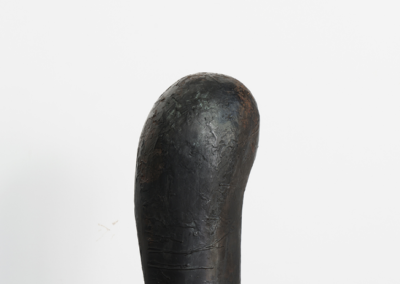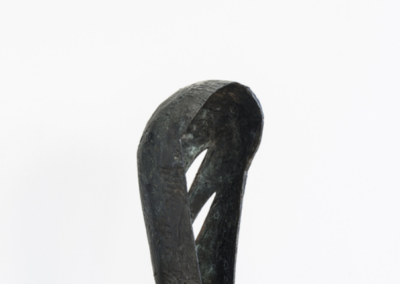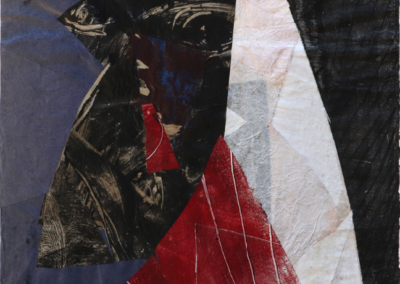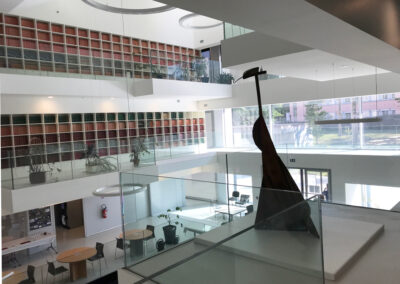Our next Artist You Need To Know is sculptor, architect and filmmaker Vincent Barré. His career has spanned over half a century, primarily in France. Vincent Barré studied with American architect Louis Khan in Philadelphia and then worked with the architecture firm Barton Myers in Edmonton and Toronto in the 1970s. Upon returning to Paris, he devoted his practice to sculpture and became known for cast-iron and bronze constructions that relate human form to architecture and landscape. (from here)
Critic Geraldine Caron offers the following about his work: “When he explains his work, Vincent Barré talks about materials, volumes, spaces, tensions, points of contact, scale, relationship to humans, to time, to the contemporary. Spontaneously, the gestures that accompanied the creative process come to illustrate his discourse, and the artist generously shares with us the genesis of his creations.” (from here, where Caron responds to Barré’s retrospective exhibition Under the tall trees, at the Matisse museum, in Cateau-Cambrésis, France).
From the text for his exhibition Maisons/Ateliers : “Barré’s sculptures seem, at least, when we first encounter them, to be self-sufficient, albeit mysterious objects, unlike anything but themselves. They fascinate us because of their intrinsic properties. Yet we soon discover how richly allusive these enigmatic forms prove to be. If we spend some time with Barré’s seemingly elemental structures, we not only become more aware of their subtly distorted geometric underpinnings, but we also find that they provoke a host of associations with everything from the human body to a surprising range of man-made things.” Barré has also worked in the two dimensional sphere, creating a number of monotypes, on fragile papers, that are primarily focused upon monochromatic explorations of space, form, perspective and ‘dimensionality.’
-

Large Ex-voto – Torso , 2015
-

Monotype 26, 2020
-

Untitled #7, 1989
-

Untitled, 2003
-

Metopes suite II, b, 2019
-

Metopes suite II, d, 2019
Barré’s sculptures are large, and any encounter with them is inherently physical, whether it be how they invite touch, or help define the space viewers stand within, with them. Many are abstract configurations of the human form. His primary process is the “lost-wax method [where] he molds hot wax into hulls, scratching and scraping the material to create tactility. The work is then cast in bronze at the foundry. Barré completes the work by painting varnishes and oxides onto the bronze. The result is a richly textured surface which is enhanced by brilliant patinas unique to each sculpture.” (from here)
-

Standing - Fluted, 2019
-

Grand Hole - Y, 2019
-

Smoky Earth XVII, 2017
-

Smoky Land XIX, 2017
-

Ex Voto, volute, 2013
-

Ex Voto, volute, 2013
Vincent Barré has had exhibitions at numerous European museums including the Matisse Museum in Le Cateau-Cambrésis, France; the Musée d’art moderne André Malraux in Le Havre, France; the musée des Beaux-Arts et d’Archéologie in Besançon, France; the Centre d’Art Contemporain du Luxembourg Belge in Virton, Belgium; and the Rijksmuseum Twenthe in Enschede, Netherlands. As well, Barré has had shows mounted in Tianjin and Jinan (both in China); Delhi, India; Bremen, Germany; and in New York at the New York Studio School – and taught in all of those places, as well. From 1995 to 2011, Barré led many sculpture workshops at Beaux-Arts de Paris. For over three decades, Barré led architectural and public art programming as artist-advisor to the City of Amilly, Loiret.
“The integration of art in outdoor spaces is at the forefront of the artist’s practice.” (from here) His site-specific work can be found in several vineyards in France, including Château Cadillac, Bordeaux; Haut Selve, Graves; Château de Laubade, Armagnac; David vineyard near Avignon; and Chateau Sainte Roselinde, Les Arcs. Barré was commissioned to make several commemorative sculptures in France – the Monument to the Resistance fighters of Nivelle, Amilly; a column of branches in homage to the Companions of the Liberation, Paris; and Crown and Chaos, in Chaumont-sur-Loire. Internationally, his public sculptures can be found at the Gerhard Marcks Haus in Bremen, Germany and the Tianjin Academy of Fine Arts in Tianjin, China. An extensive list, with many images of these works and others, can be found at his site, here.
Born in Vierzon, France in 1948, Barré lives and works in Paris, Normandy and Loiret. His own site offers a much more extensive archive of his artworks, and we encourage you to visit it here.
























